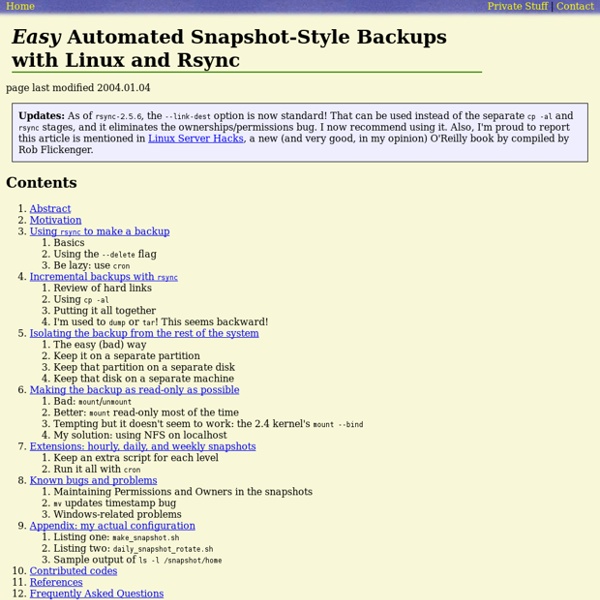rsnapshot
BackupPC Information
Three BackupPC mailing lists exist for announcements (backuppc-announce), support, asking questions or any other topic relevant to BackupPC (backuppc-users), and a developers-only list (backuppc-devel). The backuppc-announce list is moderated and is used only for important announcements (eg: new versions). It is low traffic. You only need to subscribe to one list: backuppc-users also receives any messages on backuppc-announce. You are encouraged to subscribe to either the backuppc-announce or backuppc-users mail list on sourceforge.net, by going to BackupPC-announce, or BackupPC-users. Archives for the BackupPC mailing lists can be found at BackupPC-announce-archive, BackupPC-users-archive, or BackupPC-devel-archive. The SourceForge mail lists are not always up to date, and searching is not very flexible. You can send email to the BackupPC-users list at backuppc-users@lists.sourceforge.net.
rsnapshot/rsnapshot
DeltaCopy - Rsync for Windows
Features Unlike "rsync", DeltaCopy is a only available for Windows and is tightly integrated with services available only on Microsoft platforms (XP, 2000, 2003, Vista, Windows 7 & 2008). Here is a list of features Incremental backup - Copies part of the file that is actually modified Task scheduler - Profiles in DeltaCopy can run based on a schedule Email notification - Administrators can receive email confirmation on successful as well as failed transfers One-click restore - Backed up files can be easily restored. Windows friendly environment - No need to manually modify configuration files or play around with command line options. Licensing DeltaCopy is freely available under GNU Public License version 3 along with source and is currently being maintained by Synametrics Technologies. System Requirements XP, 2000, 2003, 2008, Vista and Windows 7. How to use it DeltaCopy is based on a Client/Server model. Following steps show how to use DeltaCopy. To-do task on the server
How can I secure connections between linux/unix rsync clients and cwRsync servers ?
Assuming that you want to synchronize from directory /home/user on *nix machine to directory c:\backup on Windows machine : On Windows: Install Copssh and cwRsync server. Use the same service account.Start RsyncServer and OpenSSHD servicesActivate a user and create a PKA key pair via Copssh control panel: Transfer user's private key file to Linux client.Make sure that the user and the service account has write access to c:\backupAdd a new module to rsyncd.conf : [backup] path = /cygdrive/c/backup read only = false transfer logging = yes On Linux:
Heinlein - Professional Linux Support GmbH - Howto: Backups mit rsync
Stabiler täglicher Betrieb ohne Wartungsarbeiten Komprimierter Transfer der Daten im Netzwerk Bandbreitenlimitierung des Backup-Prozesses Sicherer Transfer der Daten – ssh-verschlüsselt Snapshot des gebackupten Systems, Rekonstruktion eines bestimmten Zustandes vor n-Tagen möglich Bequemes Backup auf einfachen Festplatten, ohne teuren Tape-Roboter oder teure Bandlaufwerke. Schnelles Zurückspielen der Daten in Festplattengeschwindigkeit möglich (schneller als Bandlaufwerke) Wir haben unsere rsync-Lösung im Linux-Magazin Heft 9/04 vorgestellt. Die Technik rsync kann Verzeichnisse auf zwei Rechnern abgleichen und synchronisieren. Wird eine Datei geändert, wird rsync diese Änderung übertragen und in das Backup einpflegen. Wir sind dadurch in der Lage täglich eine neue Snapshot-Kopie zu machen, die keinen Speicherplatz kostet, solange sich nichts ändert. Möglicher Nachteil dieser Vorgehensweise: Die Daten sind nicht komprimiert auf der Festplatte. Die Scripte Die Absicherung über SSH Literatur
How To Set Red hat / CentOS Linux Remote Backup / Snapshot Server
Q. I've HP RAID 6 server running RHEL 5.x. I'd like to act this box as a backup server for my other Red Hat DNS and Web server. Filesystem snapshot - for local or remote systems.Database backup - MySQL backupSecure - Traffic between remote backup server is always encrypted using opensshFull backup - plus incrementalsEasy to restore - Files can restored by the users who own them, without the root user getting involved.Automated backup - Runs in background via cron.Bandwidth friendly - rsync used to save bandwidth Sample setup snapshot.example.com - HP box with RAID 6 configured with Red Hat / CentOS Linux act as backup server for other clients.DNS ns1.example.com - Red Hat server act as primary name server.DNS ns2.example.com - Red Hat server act as secondary name server.www.example.com - Red Hat running Apache web server.mysql.example.com - Red Hat mysql server. Install rsnapshot Login to snapshot.example.com. rsnapshot-1.3.0-1.noarch.rpm: OK Configure rsnapshot Step # 2: Configure rsnapshot
keychain: Set Up Secure Passwordless SSH Access For Backup Scripts
We establish connections to remote systems without supplying a password, however I do not want to store my password less keys ( passphrase-free keys) on my servers. ssh-agent, takes care of keys with passphase, which allowing me to easily have ssh-agent process per system per login session. How do I dramatically reduces the number of times I've to punch my passphrase from once per new login session to once every time my local server is rebooted? How do I use keychain utility for all my backup scripts for secure passwordless login? OpenSSH offers RSA and DSA authentication to remote systems without supplying a password. keychain is a special bash script designed to make key-based authentication incredibly convenient and flexible. How Does Keychain Make It Better Than a Key Less Passphrase? If attacker broken into server with passphrase-free keys, all other your servers / workstation on which keys are used are also security risk (they can be easily breached). Install keychain on FreeBSD



